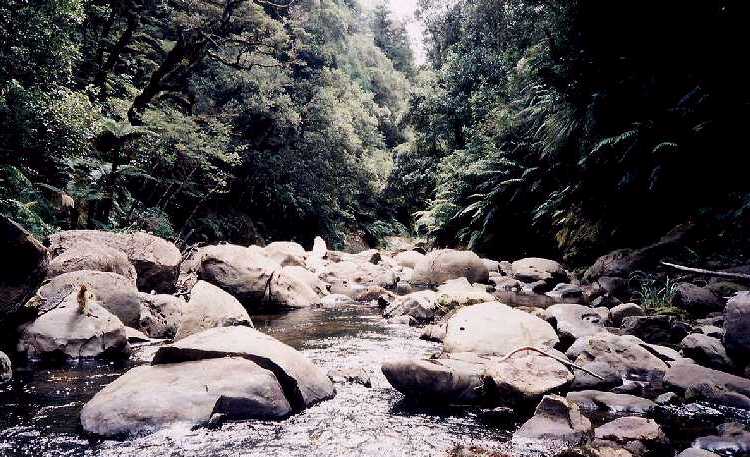
Mesozoic Marine Monsters of the Mangahouanga
....and elsewhere In New Zealand
New Zealand’s Sea Reptiles From the Time of the Dinosaurs, and Their Fossil RemainsCopyright © 2000-2009 by Mike Everhart and David Lewis
Last updated September 18, 2009
 |
Mesozoic Marine Monsters of the Mangahouanga ....and elsewhere In New Zealand New Zealand’s Sea Reptiles From the Time of the Dinosaurs, and Their Fossil RemainsCopyright © 2000-2009 by Mike Everhart and David Lewis Last updated September 18, 2009 |
Boulder Beach, Mangahouanga Stream (Lower Cretaceous, New Zealand), 13 Jan 1995. Photograph Copyright © Joan Wiffen,Used with Permission
This web-site has been created as a resource for fostering interest and understanding of New Zealand’s Mesozoic marine fossil environments, its remarkable fauna and a likewise remarkable history. This web-site will disappoint those visitors whom identify themselves as dinosaur enthusiasts, but if you have interests in these terrestrial reptiles, we would recommend John Long’s excellent book, for which bibliographical information may be found in the "Suggested Reading List". Rather than repeat other background information in my web-site about Mesozoic marine reptiles, please make use of the links to web-sites provided – they come with our personal recommendations!
Most of the photographs in this site have been kindly provided by Joan Wiffen, New Zealand’s "Dinosaur Woman", and it is to her that the New Zealand’s modern renaissance in Cretaceous vertebrate palaeontology is founded, and largely continues. We are extremely grateful to both Joan, and John Long, whose mosasaur diagrams illustrate this web-site also, for their permission to use their material. John’s book is listed in the suggested reading.
See Joan Wiffen in the June 2000 issue of Discover Magazine - Romancing the Bone by Jack McClintock. Additional photographs taken of museum specimens by Steve Anderson have been added in the latest update (6/2003)| I had the opportunity to meet and to have dinner with Joan Wiffen, and her son and daughter, at the 2004 Annual Meeting of the Society of Vertebrate Paleontology in Denver, Colorado, where she was honored with the 2004 Morton F. Skinner Award. I was very impressed! (M. Everhart) |
Most pictures are 'thumbnails' - 'Click' on them to see the larger image.
 |
Joan Wiffen, affectionately known "the Dragon Lady" fervently maintains her passion and zeal for New Zealand prehistoric flora and fauna. Work at the Mangahouanga location began in the early 1970’s with Joan’s husband Pont, and fellow fossil-hunting associates. The rich and unique fossil fauna from Mangahouanga, and Joan’s descriptions of them, necessitated a welcome revision of our previous understandings regarding New Zealand’s Mesozoic terrestrial fauna. |
 |
Joan "striking the pose" in the Mangahouanga Stream during a 1998 field trip. One of Joan and Pont’s marine reptilian recoveries (Wiffen, J., 1980) has recently been confirmed by North American mosasaur expert Gorden Bell (et al) as a "..very important taxon that is morphologically unique.." |
 |
Mosasaur right quadrates; anterior view - left: Mosasaurus flemingi; right: Mosasaurus mokoroa. |
 |
Mosasaur skull Rikisaurus tehoensis (Wiffen) specimen number NZGS CD 531. Recovered from Mangahouanga Stream by Joan Wiffen. |
 |
Juvenile mosasaur bones aff. M. mangahouangae. Specimen NZGS CD 532. |
 |
Mosasaur skull, aff. Prognathodon overtoni (Williston), specimen number NZGS CD 535; currently on display at Te Papa Tongarewa, Wellington. Recovered from Mangahouanga Stream by Joan Wiffen. BELOW: Recent photos by Steve Anderson showing right-side, frontal and left-side views of the skull. |
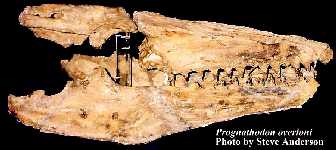 |
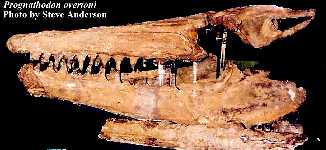 |
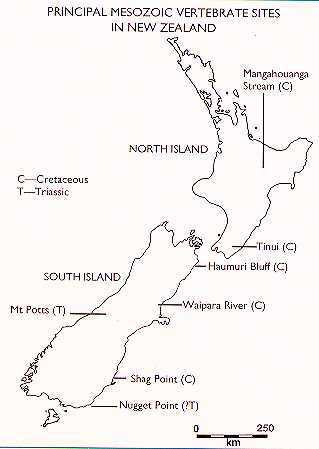 |
Click to see a Mesozoic Timescale for New Zealand Fossils |
New Zealand Marine Reptilian Fossils – "Where, When, Who and What"
Mangahouanga Stream
Where: Mangahouanga Stream (a tributary of Te Hoe River), northwest of Napier Maungataniwha Sandstone (Piripauan-Haumurian Stages); Tahora Formation
When: Discoveries began in 1974
Who: M.A. (Pont) and Joan Wiffen, Trevor Crabtree, Bill Moisley; and other members of the Hawkes Bay Palaeontological Group
What: Material diagnosed to genus and species level: Moanasaurus mangahouangae, Tuarangisaurus keyesi, Rikisaurus tehoensis, Mosasaurus flemingi, material with affinities to Prognathodon overtoni. Refer explanatory information in "Current and Future Work" and reference Bell (et al) in "Suggested Reading List" Diagnosed to family level only: Plesiosaurid (pliosaur and elasmosaur) and protostegid (large marine turtle) material Marine vertebrate material includes that of a batoid (sawfish) and other sharks Terrestrial vertebrate fossils includes ankylosaurian (probably nodosaurian), theropod, and pterodactylian material.
Very large (450mm) centra and (1060 mm) ribs described by Hector (1878) from Mount Potts (Central Canterbury) were supposedly collected by A. McKay in 1877; however specimens approaching these original dimensions were never located following their description by Hector. Further material from this locality was added by Fleming and P. B. Andrews in 1969; it included a variety of centra and ribs. The material has been dated from the Oretian Stage, (Late Triassic). Prior to the very recent discovery of New Zealand pachypleurosaurid material of Anisian (Mid-Triassic) age, had been noted by Fleming (et al) as the oldest fossil tetrapod material known from New Zealand.
The Otamita Stream fossil material, comprising broken jaws and teeth, is also of Late Triassic age, but from the slighter younger Otamitian Stage, discovered by J.D. Campbell of the University of Otago Geology Department in 1964. Campbell notes that a particular feature of these teeth enabled British palaeontologist Dr Alan Charig to assign the material to the Shastasauridae, being the only one among three Triassic ichthyosaurian families with such a feature.
When & Who: Amateurs collected material prior to that by Haast in 1869, however it was Haast’s, followed by those of Travers in 1871 (Taniwhasaurus oweni and Mosasaurus mokoroa), and McKay during 1872-73, that the historic early descriptions by Haast (1870) and Hector (1874) became widely known. Unfortunately, material recovered during extensive collecting at Haumuri Bluffs by McKay in 1876, was lost following arrival in the United States. Hector himself arranged for this large shipment aboard the Theresa Cosulich for later examination by that icon of early American fossil collecting, Edward Drinker Cope.
Refer to the web-pages headed "Current and Future Work" for detail of the recoveries from early in 1999.
What: Material diagnoses to genus and species level: Mauisaurus haasti, Tylosaurus haumuriensis, Taniwhasaurus oweni, Mosasaurus mokoroa. Material diagnosed to family level only: A range of plesiosaurid, elasmosaurid, polycotylid, mosasaurid, and reptilian material
Conway and Jed Rivers
Where: Conway River (mouth approximately 5 km south of Haumuri Bluff. Jed River (mouth approximately 5 km southeast of Cheviot)
(Haumurian Stage); Laidmore Formation
When & Who: M. mokoroa - between 1874-1895; collector unknown (Welles & Gregg, 1971) M. haasti – J. Haast, 1870
Refer "Current and Future Work" for new information regarding mosasaurian material from the Conway River
What: (Cheviot - probably Jed River) M. mokoroa (Jed River) Mauisaurus haasti
Waipara River
Where: Bobys Stream and Heathstock locations approximately 15 and 25 km from Waipara township respectively, (Haumurian Stage); Laidmore Formation. The Waipara River itself is immediately south of the township, the mouth however is some 10 km from the township
When & Who: The credit for magnificent specimen of Prognathodon waiparaensis recovered in 1963 goes to a number of individuals; Welles and Gregg (1971) should be referred to for detail. M. haasti – Both Julius Haast and Alexander McKay collected a range of material Welles and Gregg detail various dates for these collectors between 1869 and 1876. Later collectors of referred specimens include S. Sylvester in 1925, R. H Withell in 1925 and R. Speight, 1926. Elasmosaurid and Polycotylid material - refer Welles and Gregg for details, but collectors included Hood, Haast, McKay, Withell, and Holmes. Mosasaurid material (no more specific identification possible) - Travers "1866, 1867, or 1869"; McKay, 1873.
What: Material diagnoses to genus and species level: M. haasti (Heathstock) Upper Waipara River, Waipara River, Bobys Stream "Tylosaurus haumuriensis" (this genera and species understood to be under revision by Bell (et al) - refer "Current and Future Work" and P. waiparaensis. Material diagnosed to family level only: Elasmosaurid, polycotylid, plesiosaurid , and mosasaurid material
Representative Marine Reptile Fossils from New Zealand
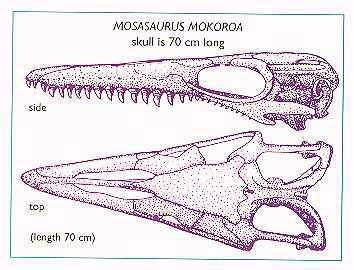 |
Mosasaurus mokoroa (side and top views) This species is the New Zealand representative of the cosmopolitan mosasaurines. The skull material depicted is this graphic is from the Jed River, North Canterbury. |
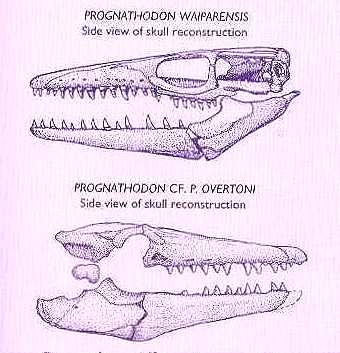 |
Prognathodon waiparaensis
(side reconstruction.) Recovered from the Waipara District, North Canterbury, this reconstruction is based on substantial skull material, and complete measures over 1 metre in length, and currently on display at the Canterbury Museum. Fossil material from this genus has also been recovered from Belgium.
Prognathodon cf. P. overtoni (side view) Based on material from the Mangahouanga Stream, this skull reconstruction has been re-assigned by Bell (et al) to M. mangahouangae (as yet unpublished). |
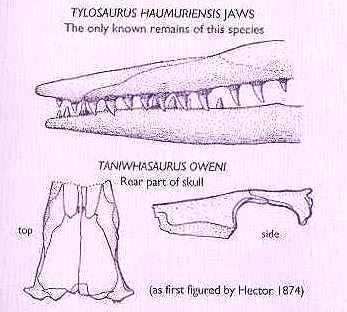 |
Tylosaurus haumuriensis (side view) The only known remains of this endemic tylosaurine, this jaw reconstruction depicts the earliest discovered and extant fossil material, from Haumuri Bluff. An estimate of skull length (based upon the preserved material) is in excess of 1110 mm, and in this genus is only exceeded by the University of Kansas’ specimen of T. proriger at 1195 mm. Taniwhasaurus oweni (top and side views)This tylosaurine has the prospect of becoming much better known with more material becoming availability for study from Haumuri Bluff. Besides the material illustrated opposite, portions of a lower jaw are also known. |
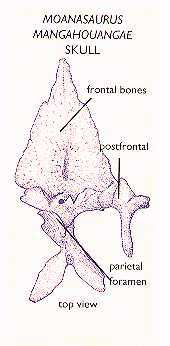 |
Moanasaurus mangahouangae (Dorsal
view) Recovered by Joan Wiffen and her co-workers in 1974, and the material described in 1980 has been confirmed by Bell and co-workers as having a number of unique features, and justifying its own genus and species assignment. |
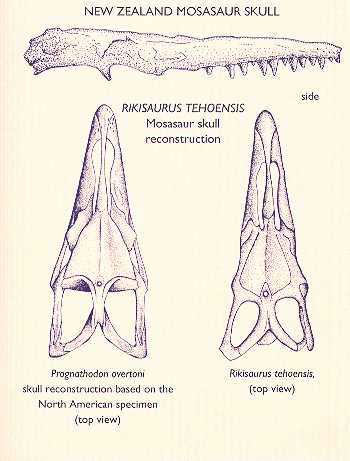 |
Rikisaurus tehoensis (right side
view) and a comparison of P. overtoni and Rikisaurus tehoensis The material in this graphic was collected in 1982 by Joan Wiffen and co-workers from Mangahouanga. Bell (et al) are understood to believe that Rikisaurus tehoensis (along with that of M. flemingi, not depicted in this web-site) should be reassigned to M. mangahouangae. |
 |
Of all the marine reptile fossil material recovered to date from what is now New Zealand, mosasaurs outnumber all other Mesozoic vertebrates in both variety and quality of material recovered - this is paleo-artist Geoffrey Cox’s impression of a mosasaur |
 |
A long-necked plesiosaur, or elasmosaur. Fossil material from two differing genus, Mauisaurus and Tuarangisaurus has been recovered from both North and South Island localities. |
 |
Plesiosaur skulls are rarely preserved, and this very complete skull of the elasmosaurid Tuarangisaurus keyesi was collected by Joan Wiffen at Mangahouanga and her co-workers in 1978. See Steve Anderson's recent picture of this skull HERE. |
 |
Fragments from the plastron and carapace of a turtle, of the family Protostegadae, have been recovered from Mangahouanga, and are thus far the only material found in the Southern Hemisphere of this family of chelonian, or turtle. |
 |
Paleo-artist Geoffrey Cox’s impression of what the paleo-environment of what is now the Mangahouanga Stream, and immediate area may have looked like - some over 65 million years ago, in Late Cretaceous times. |
 |
Mangahouanga has been a rich and productive location for the preservation of a range of a very unique marine and terrestrial vertebrate material. This artists impression by Geoffrey Cox is partly based on an impression of a pterodactyl scapula found by Joan Wiffen, and is but one example of some of the terrestrial material found thus far. |
North American mosasaur specialists Drs Gorden Bell, Michael Caldwell, and Robert Holmes, together with the New Zealand workers Joan Wiffen and Joseph McKee, presented exciting new information at the "poster session" venue. Entitled "Sea Monsters of the South Pacific - On the Late Cretaceous Mosasaurs of New Zealand", the "Suggested Reading List" entry "Bell, Gorden B. (et al) 1999" refers to important new information summarised in this reference on New Zealand’s unique mosasaurs.
During their tour to a range of New Zealand marine reptile fossil exposures in February and March 1999, the North American visitors took the opportunity to recover two concretions from the Haumuri Bluff locality, and initially involved a helicopter, and later a flat-bed truck. The mechanical and chemical preparation of the concretions by Canterbury Museum staff has since been completed. The fossils are understood to include several skull bones, the location has historically provided tylosaurine Taniwhasaurus fossil material, yet may prove to belong to another genus.
A Conway River locality has also provided further mosasaurian material recently, for which the preparation process is understood to be underway by Canterbury Museum staff.
The need for work on sauropterygian (plesiosaurs and their relatives) relationships was also highlighted by Ewan Fordyce in his 1991 treatment of the New Zealand fossil vertebrate record, yet remains uncompleted however. The most complete specimen of the elasmosaurid Mauisaurus haasti has also been recovered and prepared, from the Conway Formation of North Canterbury. This new material is hoped to allow a more complete description and diagnosis of this species.
Other recent discoveries include bone fragments, and dorsal or anterior sacral vertebra of a pachypleurosaurid sauropterygian, of Middle Triassic (Anisian) age. The six and a half metre long Shag Point plesiosaur understood to possess affinities to the Northern Hemisphere cryptoclidids, and recovered in 1983 by an Otago University team led by Ewan Fordyce remains on display at the Geology Department at the University of Otago. More information on this large specimen is hoped to be forthcoming in the near future.
Telephone: (09) 309 0443
Postal: Private Bag 92018, Auckland
Telephone: (06) 835 7781
Postal: PO Box 248, Napier E-Mail: hbct@inhb.co.nz
Telephone: (04) 381 7000
Postal: PO Box 467, Wellington E-mail: mail@tepapa.govt.nz
Telephone: (04) 570 1444
Postal: PO Box 30 368, Lower Hutt
Canterbury Museum, Rolleston Avenue, Christchurch
Telephone: (03) 366 5000
Postal: E-mail: postmast@cantmus.govt.nz
Bell, G.L. Jr, M.W. Caldwell, R. Holmes, J. Wiffen, and J. McKee. 1999. Sea Monsters of the South Pacific: On the Late Cretaceous Mosasaurs of New Zealand. Journal of Vertebrate Paleontology Volume 19, Supplement to Number 3: pp. 32A.
Caldwell, M.W., R. Holmes, G. L. Bell, Jr. and J. Wiffen. 2005. An unusual tylosaurine mosasaur from New Zealand: a new skulll of Taniwhasaurus oweni (Lower Haumurian: Upper Cretaceous). Journal of Vertebrate Paleontology 25(2): 393-401.
Campbell, J.D. 1965. New Zealand Triassic saurians. New Zealand Journal of Geology and Geophysics 8: 505-509.
Cruickshank, A.R.I., R. E. Fordyce, and J.A. Long. 1999. Recent developments in Australasian sauropterygian palaeontology (Reptilia: Sauropterygia). Records of the Western Australian Museum Supplement 57: pp. 201-205.
Cruickshank, A. R. I., and R. E. Fordyce. 2002. A new marine reptile (Sauropterygia) from New Zealand: Further evidence for a Late Cretaceous astral radiation of cryptoclidid plesiosaurs. Palaeontology, 45(3):557-575.
Fleming, C.A., D.R. Gregg, and S.P. Welles. 1971. New Zealand ichthyosaurs - a summary, including new records from the Cretaceous. New Zealand Journal of Geology and Geophysics 14: 734-741.
Fordyce, R.E. 1991. A new look at the fossil vertebrate record of New Zealand. IN P. Vickers-Rich, J. M. Monaghan, R. F. Baird & T. H. Rich (Eds.), Vertebrate Palaeontology of Australasia pp. 1191- 1316. Pioneer Design Studio, Melbourne.
*Gregg, D.R. 1974. Sea Dragons of the Mesozoic. New Zealand’s Nature Heritage 1: 84-88.
Hector, J. 1874. On the fossil reptilia of New Zealand. Transactions of the New Zealand Institute 6: 333-358.
Hiller, N. and A. Mannering. 2004. Elasmosaur (Reptilia: Plesiosauria) skull remains from the Upper Cretaceous of North Canterberry, New Zealand. Records of the Canterberry Museum 18: 1-7.
Hiller, N., A.A. Mannering, C.M. Jones and A.R.I. Cruikshank. 2005. The nature of Mauisaurus haasti Hector, 1874 (Reptilia: Plesiosauria). Journal of Vertebrate Paleontology 25(3): 588-601.
Hutton, F.W. 1893. On a new plesiosaur from the Waipara River. Transactions and Proceedings of the New Zealand Institute, 26: 354-358, Pl. XLII.Keyes, I.W. 1984. Joan Wiffen and the Mangahouanga Stream reptiles: a profile. Geological Society of New Zealand Newsletter 63: 29-32.
Knight, C. 1873. On the teeth of the Leiodon. Transactions and Proceedings of the New Zealand Institute, 6:358-364.*Long, J.A. 1998. New Zealand dinosaurs, marine reptiles and pterosaurs, pp. 160-172 in Dinosaurs of Australia and New Zealand and other Animals of the Mesozoic Era. Harvard University Press, Massachusetts.
Lundelius, E. Jr. and S. St. J. Warne. 1960. Mosasaur remains from the upper Cretaceous of Western Australia, Journal of Paleontology, 34(6):1215-1217.
Martin, J.E. and Fernández, M. 2007. The synonymy of the Late Cretaceous mosasaur (Squamata) genus Lakumasaurus from Antarctica with Taniwhasaurus from New Zealand and its bearing upon faunal similarity within the Weddellian Province. Geological Journal 42(2): 203-211.McHenry, C. R., A. G. Cook and S. Wroe. 2005. Bottom-feeding plesiosaurs. Science 310: 75.
Welles, S.P. and D.R. Gregg 1971. Late Cretaceous marine reptiles of New Zealand. Records of the Canterbury Museum 9: 1-111.
Wiffen, J. 1980. Moanasaurus, a new genus of marine reptile (Family Mosasauridae) from the Upper Cretaceous of North Island, New Zealand. New Zealand Journal of Geology and Geophysics 23: 507-528.
Wiffen, J. 1981. The first Late Cretaceous turtles from New Zealand. New Zealand Journal of Geology and Geophysics 24: 293-299.Wiffen, J. 1986. Late Cretaceous reptiles (Families Elasmosauridae and Pliosauridae) from the Mangahouanga Stream, North Island, New Zealand. New Zealand Journal of Geology and Geophysics 29: 205-252.
Wiffen, J. 1990. New mosasaurs (Reptilia; Family Mosasauridae) from the Upper Cretaceous of North Island, New Zealand. New Zealand Journal of Geology and Geophysics 33: 67-85.
Wiffen, J. 1990. Taxonomic note: Moanasaurus mangahouangae or Mosasaurus mangahouangae? New Zealand Journal of Geology and Geophysics 33: 87-88.
Wiffen, J. and W.L. Moisley, 1986. Late Cretaceous reptiles (Families Elasmosauridae and Pliosauridae) from the Mangahouanga Stream, North Island, New Zealand, New Zealand Journal of Geology and Geophysics, 29:205-252.
Wiffen, J. 1991. Valley of the Dragons: The Story of New Zealand’s Dinosaur Woman. Random Century, Auckland.
Wilson, G., Schiřler, P., Hiller, N. and Jones, C.M. 2005. Age and provenance of Cretaceous marine reptiles from the South Island and Chatham Islands, New Zealand. New Zealand Journal of Geology and Geophysics 48: 377-387.Wright, K.R. 1989. On the taxonomic status of Moanasaurus mangahouangae Wiffen (Squamata: Mosasauridae). Journal of Paleontology 63(1): 126-127.
Yarwood, V. 1993. The Hunt for New Zealand’s Dinosaurs. New Zealand Geographic 19: 102-122.
Credits: Unless otherwise noted, photographs are copyright © Joan Wiffen, and are used with her permission. Maps and drawings are copyright © John A. Long from his recent book, "Dinosaurs of Australia and New Zealand, and other animals of the Mesozoic Era," Harvard University Press, 1998, and are used with his permission.